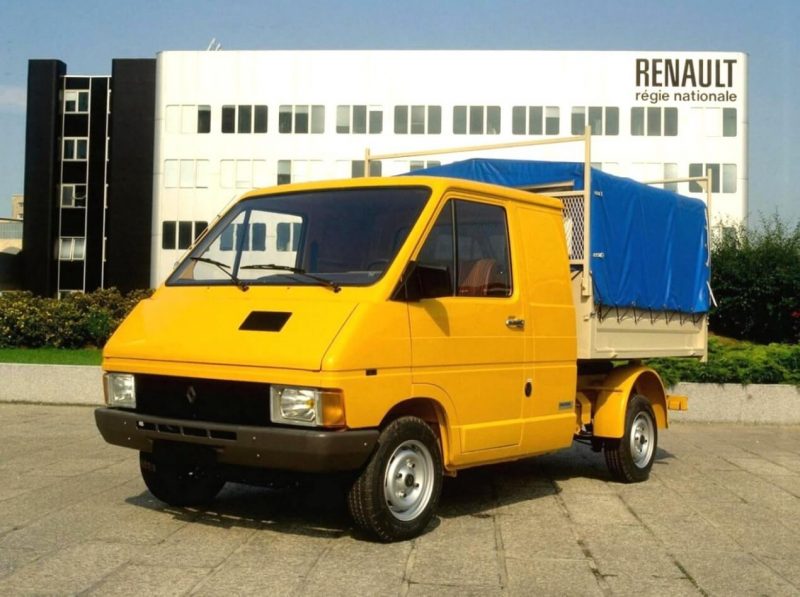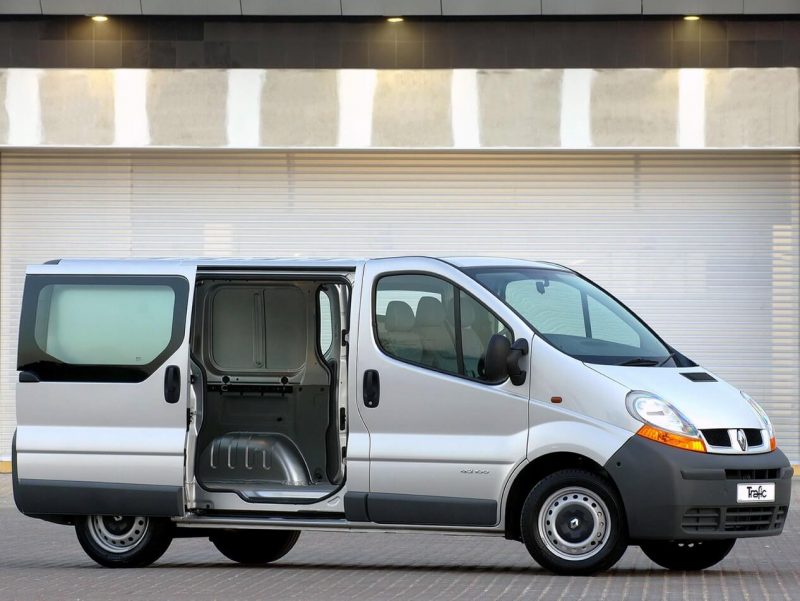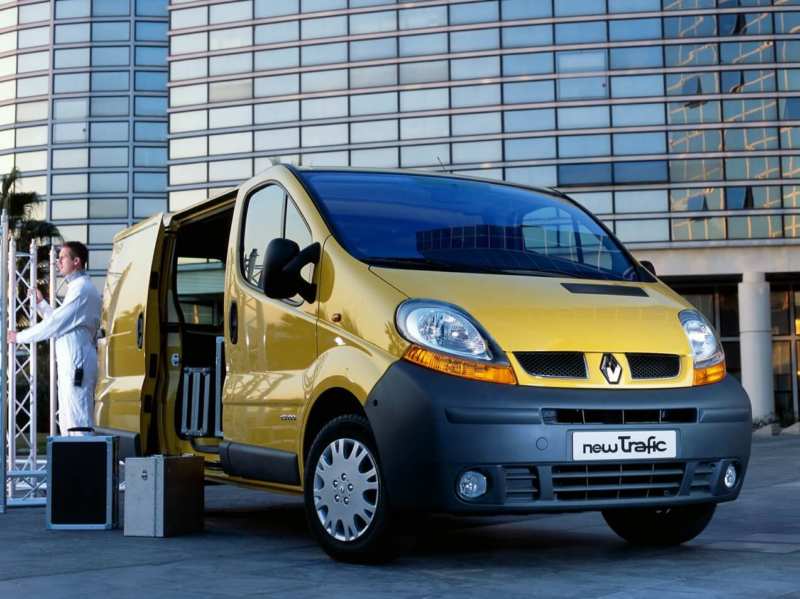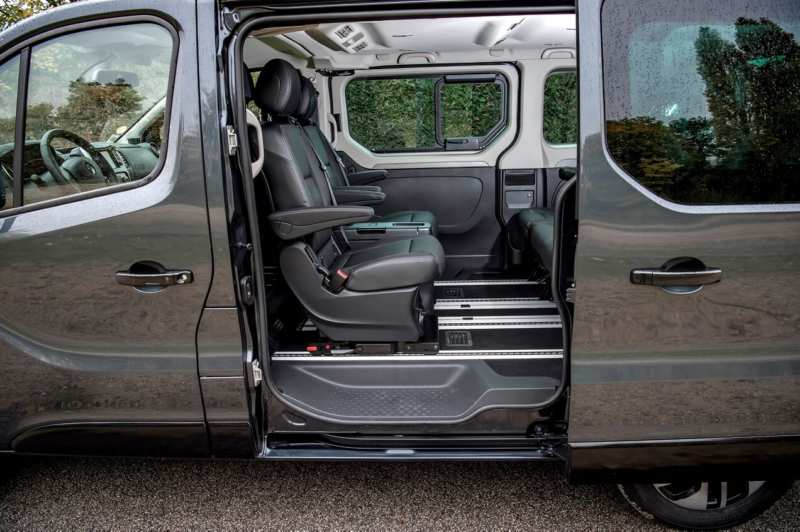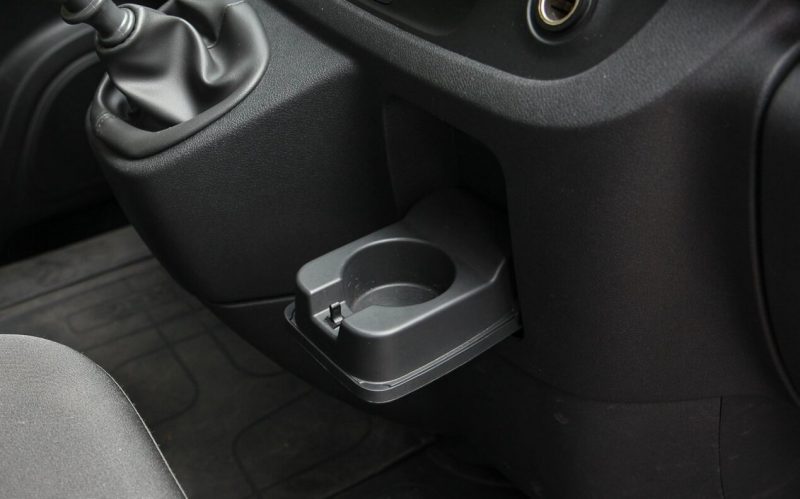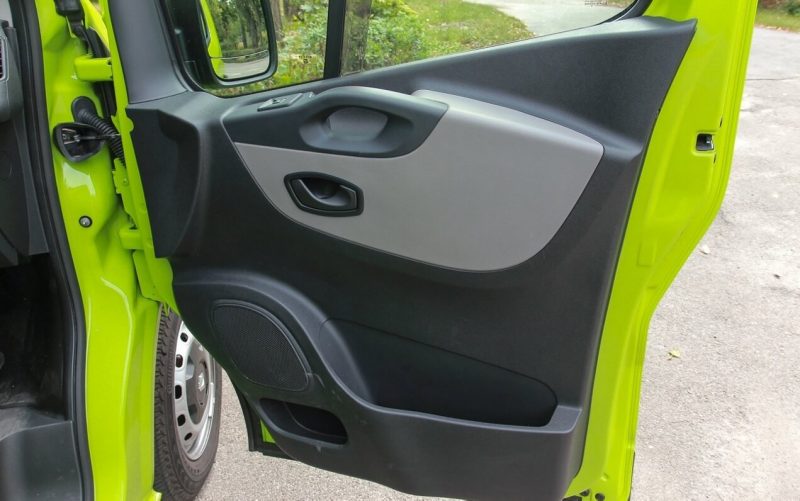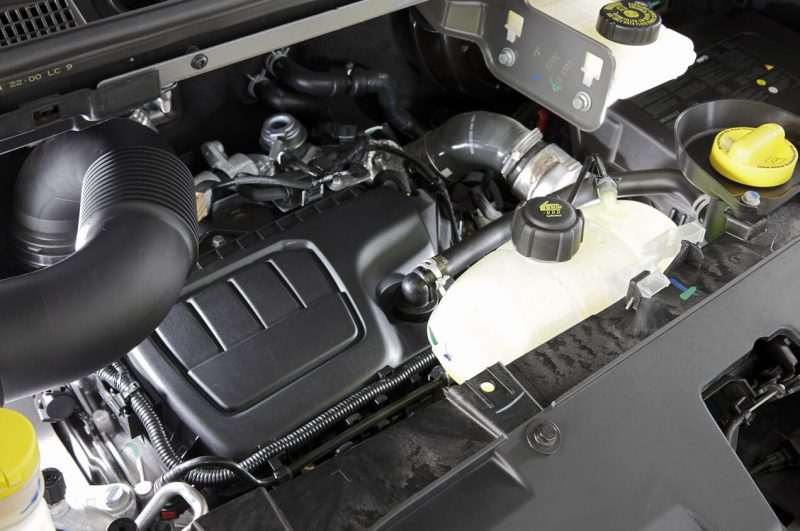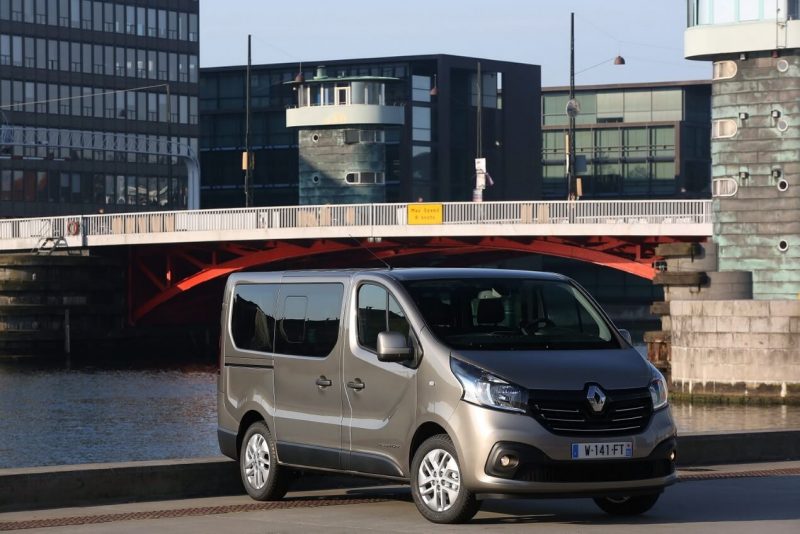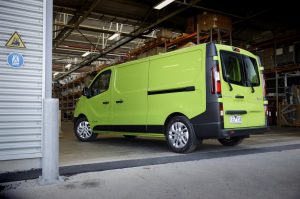Renault Trafic
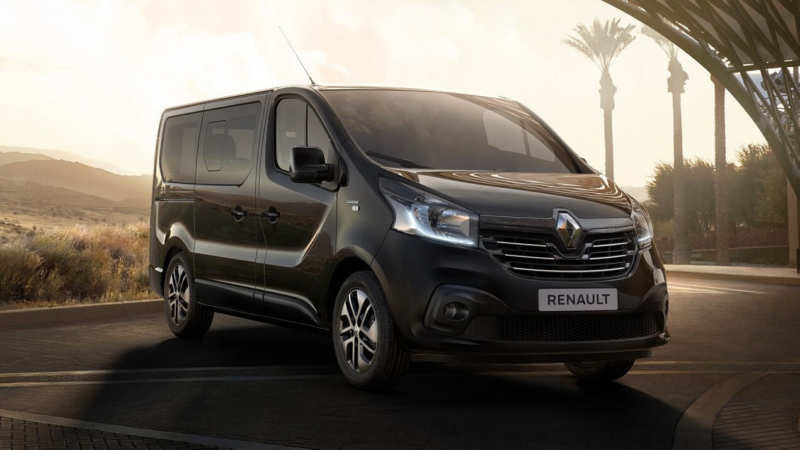
Renault Trafic presents a series of cargo vans and minivans, which Renault has been manufacturing and selling in a number of European countries since 1981. The vehicles of the family belong to the M division and are considered to be one of the safest in the car market. In total, 3 generations of the car were produced. The latest family began to sell in the summer of 2014.
The novelty has become more fresh, modern and qualitative. The “Frenchman” can be set as an example of economy, comfort and power. The model was created mainly for professional transportation. Renault Trafic has a high load capacity and a large useful volume, which greatly facilitates the transport of goods of enormous size. In addition, the vehicle is also well suited for the transport of people. The whole model range is Renault.
- I generation (1981-2000)
- II generation (2001-2013)
- III generation (2014-present)
- Appearance
- Salon
- Specifications
- Powertrain
- Transmission
- Chassis
- Safety
- Complete sets and prices
- Tuning
- Comparison with competitors
- Reviews from the owners
- The pros and cons
- Tooths
- Renault Trafic photo
- Test drive
- Video overview
I generation (1981-2000)
The French company Renault has been engaged in distribution vans with front-drive configuration since 1950. The first family of Renault Trafic was released in 1980. The debut model had front-wheel-drive frame-bearing vans, minibuses, chassis-platforms and flatbed trucks with the letter “T”, as well as frame rear-wheel-drive flatbed trucks and chassis with a cabin under the letter “P”.
After 1985, the company began to create minibuses and trucks with all-wheel drive. Such variants had an index V. It turns out that Renault Trafic trucks received all 3 modern layouts. In addition to the drive variant, the trucks differ in 5 different variants – GVW and payload.
The T800 front wheel driven vehicles had a GVW of 2,100 kg and a payload of 800 kg, the T1000 version had a gross weight of 2,300 kg and 1,000 kg, and the T1200 version had a gross weight of 2,700 kg and 1,000 kg, respectively.
Interestingly, already at the beginning of the XXI century Renault and Nissan started to use joint technologies for the production of their cars.
Capacity of the minibus, which is made on the platform of the van with a short base, was up to 8 passengers. The rear door was made of double-leaf and hinged, which made it possible to facilitate various manipulations even in tight spaces. The half of the door opens at 180°.
As for the loading height, it ranged from 475 millimeters at the van to 1,060 millimeters at the flatbed truck. Power units were placed longitudinally, which increased the payload of the front drive axle. The main powerplant was a 1.4-liter 48 hp version.
With the advent of 1984, a more powerful 1.65-liter 65 hp engine was installed, which operated together with a 5-speed “mechanically” box. In addition, a 3-range automatic transmission was provided for already then. After 1987, the French placed under the hood a 68 hp 1.7-liter power plant, and all-wheel drive vehicle had an 82 hp 2.0-liter engine.
Due to the installation of the 2.1-liter 65 hp diesel engine, the radiator grille had to be moved a little forward because the engine was more bulky. After 1987, the T1200 was renamed the T1300 because of an increase in payload by 100 kilograms. The first major update for the Renault Trafic 1 generation was in 1989. Restyling has affected some parts of the “front end”.
Specialists modified the hood, wings, front optics and radiator grille. It was possible to improve the structure and finishing of the seats, to increase the noise isolation of the cabin and to raise by an average of 100 kilograms of tonnage for the rest of the modifications (after the modernization the trucks were assigned other indexes).
Among the main engines are diesel engines. This is a 1.9-liter 61 hp and 2.5-liter 76 hp engine. The engineering staff also provided for a 2.2-liter injector power unit. A year later, a radio and door loudspeakers could be noticed on standard-packaged machines. As for the interior decoration of the vans, it was significantly improved.
After 1992, the car already had a central lock, and the T1100 model acquired a second sliding door on the port side. After 5 years, the first generation of Renault Trafic 1997 was again designed to improve its appearance. However, it is necessary to be honest, it has not saved already morally out-of-date car.
Given the more modern similar models, the ergonomics of the driver’s seat and the rectangular interior design of the primitive “dashboard” was uninteresting and boring. But it is important to note that Renault Trafic was quickly able to earn fame and was in the honor for a long time in the small and medium-sized businesses.
II generation (2001-2013)
The second generation of the Renault Trafic was released in 2001. The car was offered in 2 versions: short (3 100 millimeters) and long base (3 500 millimeters). It was possible to load the machine up to 1,200 kilograms, and the useful space got 6 cubic meters. In addition to the van, the company presented a cargo and passenger version, as well as only the passenger version of Renault Trafic 2.
The last variant received 9 seats, which includes a driver’s seat. On the second and third row of seats there are seat belts, and the seats can be easily and quickly folded. All Renault Trafic 2001 vehicles received a wide sliding side door on the right side.
The novelty has a rich possibility of transformation. Numerous configurations of doors (side and rear) and rear seats are available. Regardless of the size of the luggage compartment, it can be extended by folding seats on the third row.
Renault Trafic of 2 generations turned out to be so successful car that already in 2002 it could win the prestigious title “Van of the Year”.
Externally, the Renault Trafic 2 looked fresher and more modern, if we compare it with the debut family. The appearance of the “Frenchman” was equipped with rapid body lines, a clearly distinguished cabin, a powerful bumper and headlights of droplet shape. There is a lot of controversy over the small “hump” above the driver and the passengers sitting next to them.
Some believe that this element is ugly and impractical, others believe that such an element only decorates the car and gives a kind of highlight. However, it is important to note that with the help of this “hump”, to get into the car is more convenient and easier, and sitting directly inside you can feel the reserve over your head. It is important, because the driver’s row slightly rises above other rows of seats.
The French offered several engines as a powerplant. The diesel list included a 1.9-liter 80-horsepower engine, as well as its turbine version, which developed 100 horsepower. In addition to “diesel engines” there was also a gasoline hexadecimal power plant, which received a working volume of 2 liters. It developed such a variant of 120 “horses”.
The engines were equipped with a six-speed transmission on the mechanics. Thanks to this gearbox it was possible to increase the acceleration dynamics and reduce fuel consumption. Renault Trafic 2002 was recognized as one of the safest full-size “van” in the car market. The standard equipment has disc brakes on all wheels, height-adjustable seat belts (pretensioners and force limiters are present). There is also an electronic ABS system with EBV braking force distribution technology.
Since 2003, motorists of the French company Renault have developed a new engine for the Traffic family. It received a working volume of 2.5 liters and became the most powerful in the list of power plants. It was based on the inferior 2.2-liter version. Specialists have introduced the results of the latest research in the field of automotive industry. With the help of the latest generation of direct injection Common Rail, the engine power was increased to 135 “horses”.
The power unit works together with 6-speed “mechanics”, which significantly saves fuel when driving out of town. Combined mode allows the vehicle to consume about 8.6 liters of diesel fuel for every 100 kilometers.
In the same year, Renault Trafic received another passenger version, which was called Passanger. This version, designed for 8 people, was perfect not only for family needs, but also for use in business format. The novelty is equipped with cruise control, electric drive of external mirrors, central locking, electric windows on the front windows, hydraulic power steering and so on.
The driver and front passenger received airbags, and the rest of the passengers received 3-point belts with pretensioners and seats with head restraints and load regulators on the 1st and 2nd row. The passenger version of the Renault Trafic II can be supplied with four gasoline and diesel-powered engines. The gasoline version includes a 2-litre engine.
The diesel list received a 1.9-liter DCi, producing 82 or 100 horsepower, 2.5-liter Dci 16V16, which develops 135 “horses”. The engines meet the Euro-3 environmental standards.
The developers managed to fully endow the passenger modification with a proper level of comfort and pleasant style. For this reason, even in our time, the car can be quite often found on the roads. The car is still one of the most convenient and practical “beads” today. The convenient French model Renault Trafic of the second generation has survived two more small restylings and then it was replaced by the new third family, which will be discussed further.
III generation (2014-present)
It is not for nothing that Renault Trafic is called one of the most popular European commercial vehicles. Such a conclusion was made not in vain, because the model has a unique design, high-quality assembly and affordable price.
The new family of van, Renault Trafic 3, was a long-awaited event in the automotive market. Having gained a small restyling, the new van became one of the most stylish in its class. In addition, the novelty received a good salon and an arsenal of powerful engines.
Appearance
The new body became more cute and modern. Like all vans, it got a short face with a strongly sloping, entirely flat hood. Almost immediately the huge optics, extending from the grille to the windshield, is striking. The air inlet is large and has a trapezoidal shape, occupying a considerable part of the entire bumper area.
A large air intake is divided into several small elements by horizontal plastic lines, which go in different directions. The lower part of the bumper is also plastic. There is another small strip of cooling system and fog lights.
As for the optics itself, some attentive observers can notice the interesting similarity of the headlights with the cars from the Nissan company, and the cars in the sedan body. And here, as we can see, this solution was perfectly able to take root on the van. Also on the front end it is possible to notice the national emblem of Renault, which was made in the new style, which the company has been promoting since 2013, even for its own cars.
During the creation of the new car before the development department set the task to upgrade the car in all respects, but to preserve the advantages of the previous model and to prevent a striking rise in price. In addition, the company demanded to reduce the fuel appetite, while increasing the interior space and expanding the list of equipment.
The side of the new Renault Trafic 2019 has some relief. You can notice the presence of a large recess in the center and near the skirt. The windows and mirrors have an interesting shape that complements the overall appearance of the car. As in the front, the side area has a protective plastic layer that runs all over the bottom, except for the arches of the wheels.
Another important difference is the absence of a characteristic protrusion of the roof over the driver’s head and front passengers – now it is completely flat. The car’s profile has “lost some weight”, so there are no inflated wheel arches, the sides look more slim and supple. The rear part of the Renault Trafic of the 3rd generation no longer has such weight differences from the previous family.
The French car was equipped with doors swinginging on different sides, vertical optics of massive size, wide footboard, separated by plastic and modest exhaust under the bottom. The exterior has changed dramatically. The appearance of the rear headlights has changed a little.
It is clear that the flawlessly stylish new Mercedes Vito is still a long way off to the “Frenchman”, but the latter is much cheaper than the German and is in another class. It is pleasant that the company introduced a new range of colors, because many people waited for the appearance of bright shades.
Salon
Inside the new Renault Trafic is also much better and more enjoyable. The quality of the interior and the level of equipment has increased considerably. The machine has a pleasant fabric and plastic finish, modern equipment and a large number of different openings for things. Most of the multimedia part is assembled in a compact display located in the central part of the dashboard.
If you take the heating system and air conditioning Renault Trafic III, they are regulated in the usual way – the physical washers, placed slightly below the screen. Everything that should be placed on it is installed on the dashboard. This includes a gearshift knob and a tilting cup holder with compact dimensions. The steering wheel is rather modest and does not stand out due to its multimedia properties.
The steering wheel spokes have only four keys designed to increase or decrease the volume of “music” and to change tracks. The dashboard itself, installed directly in front of the driver, looks unusual. It has two semicircular sensors, separated at different angles, displaying the real speed of the power unit and fuel level.
In the center you can see the speedometer of digital type, and above it a small area allocated for the “board computer”. Among the innovations we would like to highlight the tips about the best switching to the speed up or down.
In the Renault Trafic III cab, the passenger seat can be folded and turned into a laptop table (up to 17 inches) with a clip for A4 documents.
The front doors are wide and heavy, and the handles are massive and horizontal. By the way, there is a step installed, because if it wasn’t for it, the process of getting into the saloon resembled a climbing. For a quality view, the French specialists installed massive windows and large external mirrors, divided into parts (the lower part is hemispherical).
Rich equipment Renault Trafic 3 generation has a central mirror with LCD screen, which transmits the image from the rear camera. To allow the owner to easily maneuver in the narrow city stream, provided parktronic. If the client wishes, it is possible to install a proprietary multimedia system with “navigation”. It will be exactly like MEDIA NAV on Renault’s cars.
However, even if a simple radio is installed, it has a convenient steering wheel control and USB-connector. An additional connector for the USB stick is located at the top of the torpedo. It allows you to charge the electronic gadget without turning off the music. Already the initial equipment Renault Trafic 2019 has received a lot of different compartments, shelves and niches.
The upper area of the torpedo has a funnel under the liquid tanks. Special coin slots were needed. In total, the cabin was equipped with 14 compartments with a total volume of 90 liters. It is possible to additionally equip the cabin with a 54-liter container, which was placed under the seat of the passenger. French engineers have developed the ventilation system and air ducts of the new Renault Trafic 3.
The middle row received deflectors placed in the leg area, and on the roof you can see a separate adjustment panel climate system. Even the rear part has deflectors. It is a pity that there is no ventilation by opening at least one window. The cabin can be 2- and 3-seater, while the backrest, installed in the center, can be folded back, creating a small table.
If we speak for the chairs, they do not stand out for their high quality of landing. The upholstery is fabric, rigid filling. The seats are not electronically adjustable and have no side supports. Heating is the only expensive option. I am glad that already in the basic equipment there is a function of adjustment of height of a pillow of a driver’s seat.
Inside you can install 2 rows of seats designed for 3 adults or a cargo compartment that can accommodate up to 1 200 kg of cargo. The middle row of seats has the function of tilting one section. This has been done so that it is easy to get in and out of the car for people sitting on the gallery.
The third generation of Renault Trafic has an enlarged luggage compartment with a capacity of 1,800 litres. If necessary, it can be enlarged by removing the rear sofa, which provides 3,400 litres of storage space. The fact that the seats are dismantled and the floor is completely flat also makes you happy.
Specifications
Powertrain
A team of engineers from France has developed new powertrains for Renault Trafic 3. The engines are powered by gasoline and diesel. The engine capacity will depend on the equipment. The output of the 1.6-liter DCI diesel engines will also vary from 80 to 140 horsepower. Together with the Twin-Turbo system, the novelty will be accelerated to the first hundred in only 13.8 seconds.
The engines boast excellent economy. In the city the car will consume about 7.4 liters per every hundred kilometers. This indicator will fall to the level of 5.7 liters after driving on the track. Do not forget about the “magic” button ECO, which allows you to increase the economy by 10 percent. This is the assurance of the representatives of the French company, as time will show in reality only.
Transmission
Quite tractive power units work together with a 6-speed mechanical box, which is distinguished by smooth switching. The entire torque is only transmitted to the front wheels. The maximum speed is 155 km/h.
Chassis
The French only decided to improve the suspension of the new generation van a little bit. Ahead of it is an independent suspension with McPherson stands. The rear part also received an independent, spring suspension. Road bumps are effectively absorbed by the energy-intensive suspension, which has received new shock absorbers. The new machine is easy to operate with the aid of a steering (pinion) rail complemented by an electric power steering.
The brake system has disc mechanisms on all wheels. At a speed of 100 kilometres per hour, the Renault Trafic III will only have a braking capacity of 43 metres. Even some passenger cars cannot achieve this result.
Safety
The French brand Renault wishes to provide maximum protection to all passengers inside the car and provides its model with a wide range of reliable security systems:
- Three-point seat belts;
- Frontal driver’s airbag;
- Front airbag for front passenger with deactivation function;
- Side airbags and curtains;
- Anti-rollover technology on slippery roads, which can be activated using a special button to the left of the hand wheel;
- Anti-rollover system for climbing;
- Electronic systems ABS, EBV and Emergency Brake Assist technology;
- Trailer Sway Control technology, which eliminates the swaying of the trailer by optimising the speed of the powertrain and braking one of the driving wheels.
Complete sets and prices
To buy a new restyled model of Renault Trafic 2019 in the basic configuration, you will have to give a minimum of 15 285 $. This option will have an anti-locking and stabilization system, central locking, heating function and wipers for the windows of the rear doors, stove, air conditioning and two airbags.
The top version is estimated already from 19 871 $. Equipping with such an option includes cruise control, air conditioning system, a large number of airbags, front seat heating function and front electric windows.
Tuning
Taking into account the fact that recently a restyled version of Renault Trafic 3 generation was released, it is unlikely that anyone would want to seriously tuning it, because the car looks very stylish and modern both externally and internally. However, it is possible to buy and install new seat covers, mats, window deflectors, protective film on the sills (for example, from carbon) and so on.
Such tuning of Renault Trafic can be done independently. More serious improvements in terms of appearance of the car may be inappropriate, although everyone has their own thoughts on the subject.
Comparison with competitors
The struggle in the market of “beads” is serious, that’s why the French decided to release a restyled version of their “sensational” car. However, buyers can also look away Volkswagen Transporter, which is the best-selling car of the year in this niche.
In addition, there is a Korean Hyundai H1, which received a rear-wheel drive, which is very inconvenient for the Russian winters. The choice can also fall on Opel Vivaro, Mercedes Vito and Chevrolet Express.
Reviews from the owners
Judging by the feedback from Renault Trafic owners, the car is very practical, comfortable and mobile. Drivers note excellent visibility, comfortable and spacious enough 2 rows of passenger seats. Very economical power units. I would like to say separately about the two-level luggage compartment, which allows not to worry about transportation. Power and torque are enough with the head, and for racing it is better to buy another car.
The new design of the third generation makes the car more stylish and modern. Galvanized bodywork will not worry about its wear and tear for a long time. The car is suitable for work, big family or travelers. Some reviews of Renault Trafic show the expensive maintenance, the cost of spare parts, expensive fuel system and a little bit harsh suspension.
The pros and cons
Pluses cars
- Stylish, modern and challenging;
- Economical and large fuel tank;
- High level of comfort and convenience;
- Not very expensive service;
- High ground clearance;
- Front drive (much better than rear drive);
- High level of safety;
- Pulling power units;
- Electronic help systems;
- Lots of free space;
- Huge luggage compartment;
- Many variants of transformation of interior.
Cons of a car
- The inconvenience of a manual gearbox
- Not the lowest price tag in its class;
- There is no all-wheel drive system;
- Tough suspension.
Tooths
The release of the third generation of the French Renault Trafic 2019 has breathed new life into the world-famous model. Even the second generation still looks good and is very popular. Therefore, the third family will allow for a long time to compete successfully in the automotive market with its rivals.
The novelty has a new and stylish appearance, nice headlights, punches on the side. The car still has high ground clearance and front wheel drive. Inside the Renault Trafic 3 became much more comfortable. The quality of the finishing materials is far from ideal, but it fits the purpose of the machine and feels good enough.
Potential buyers will be glad to see the spacious salon, unusual dashboard and color display of the multimedia system. It is important to mention the high level of safety and the various electronic auxiliary systems built into the vehicle.
The French specialists were able to improve the model without taking away its existing advantages. The engines consume a little fuel, but allow you to move dynamically in urban traffic. It is safe to say that Renault Trafic 3 generation will not disappoint its customers.
We advise you to read the article: Renault history




